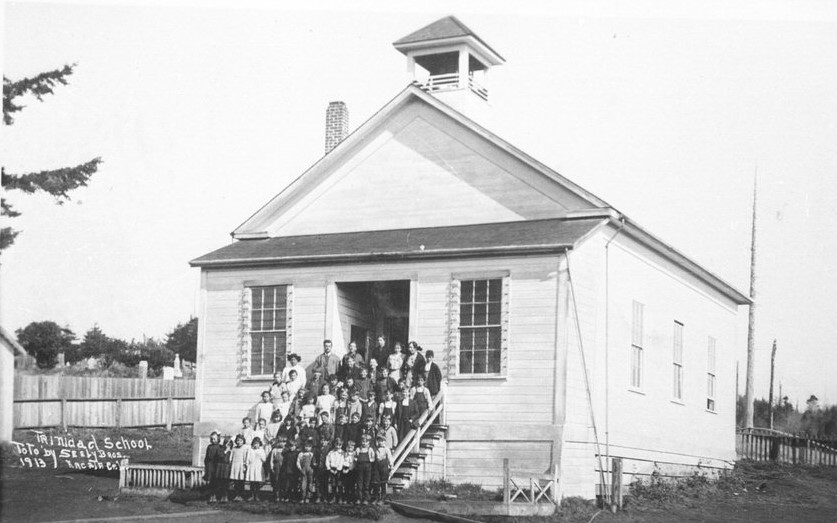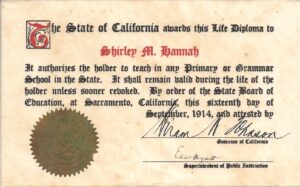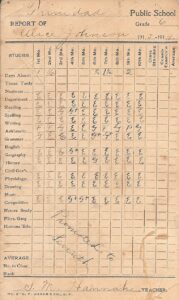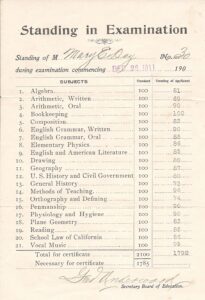
The first Trinidad School was built in 1870 near the cemetery. It was a one-room, one teacher school constructed by Henry Gastman at a cost of $220 on a 75′ x 150′ lot given to the town by lumbermen J.P. and J.A. Hooper. Gastman was not paid in full and went to court to settle the matter. C.R. Saunders (no relation to the Mose Saunders, who came to Trinidad in 1919) taught there from 1870 to 1874.
There were nine or ten families (with four or five children in each family) which sent their children to school, including Warren Watkins, Josiah Bell, L. Bell, John Haskell, Fred Flaherty, W.H. Pinkham, Nichols, McClosky, Brown and Snow, according to Sibyl Jamieson, whose research is included in the “Trinidad News & Views Historical Happenings” columns, written between 1980 and 1985 and reprinted by Trinidad Museum Society.
Teachers through the years were: Dickson (1874-1881); S. Handy (1889); Cornell (1896-1899); Daisy Allen (1898), Wallace Feenaty and Drake between 1900 and 1911; and Shirley Hannah (1911-1915). Percy Woodcock followed in 1919 and later became Superintendent of Humboldt County Schools.
Shirley Hannah, whose art work is featured in the exhibit, was 23 years old and had two years of previous teaching at Klamath River schools when he arrived in Trinidad on January 15, 1911 to meet with the School Board of Trustees and to get settled as a boarder in the Sangster’s Ocean View Hotel (today’s Eatery Restaurant on Parker at Trinity Streets). Mrs. Kristina Sangster, of Danish descent, was his landlady, and “what a wonderful cook she was” wrote Hannah in his “Country School Teacher Reminisces” in three 1969 issues of “The Humboldt Historian.” He added, “For a person who follows a sedentary occupation a little exercise and fresh air is necessary to keep one in good health and build steady nerves…so several times a week when the weather permitted, I would walk to Luffenholtz and back before breakfast…it stimulated the appetite and I can still appreciate the steaks and friend eggs that Mrs. Sangster often gave me for breakfast.”

Trustees of the school were James Underwood, who with his wife, Martha, kept a grocery store, Robert Probst and George Scott, Postmaster. Other Trustees were; Warren Watkins, Mrs. Mary Thompson Johnson (Mother of Alice Johnson) and Allen Hyner.
Hannah was paid $100 per month for ten months. He taught eight grades and 62 pupils to begin the term. Hannah wrote that “the one thing that impressed me about the pupils was their friendliness and willingness to help a new teacher…of course in a school of that size and so many classes, it was necessary for the program to go along like clockwork…outlining a subject was a method I used in teaching…which produced very good results, so the pupils made outlines of geography, history, grammar, physiology and even arithmetic.” At the end of his first year, the Trustees asked him to teach a post graduate class in addition, which he agreed to do. He taught French, algebra, ancient history, geometry and advanced arithmetic to the older students. Some of his pupils were: Willie Snow, Charlie Beach, Vera Flaherty, Irma Probst, Martha Sangster, Edith Tighe, Esther Hobson, Cynthia Day, Warren Underwood, Willie Goselin, Roy Goselin, Albert Sangster, Earl Cunningham, Eunice Wells, Greta Flaherty, Louise Scott, Alice Johnson, Hazel Hobson, Albert Ehreiser, Frank Pidgeon, George Dryden, Mary Beach and Annie Morton.

In 1913, the Board of Trustees voted for two teachers and a new school. They hired Mary Day, a local girl whose parents owned a ranch on Old Stagecoach Road (Jim and Virginia Waters’ home today). Shirley Hannah wrote in his reminisces “As the new teacher and I became better acquainted, it became evident to me that she would make an excellent ‘boss’ so later on (1918) we got married. Her name was Mary Day and believe me, I’ve had a ‘merry day’ of it ever since. That surely was my lucky year.” (Shirley Hannah and Mary Day are the parents of Thomas Hannah, who has contributed many photographs, documents, books, and objects to the museum). Two woodsheds were placed on the property as a temporary room for the primary grades where Mary Day taught until the Fall of 1914, when a new school was ready at the current Trinity Street school location after the first school burned down.

The new school was a two-story redwood building with four rooms with a large hall running between and heated by a basement furnace. This school was built on four acres and included a basketball court, but it too was destroyed by fire in the late 1940s.
While a new third school building was being constructed on the same parcel as today’s Trinidad School, classes were held in the Town Hall and the Presbyterian Church next door to the school.
In 1949, the school enrollment was 145 with seven teachers, according to Katie Boyle, who began teaching at Trinidad School that year after serving at Little River (Crannell) School. Kenneth C.B. Williams was Superintendent. The new school building was ready for occupancy in 1950. It contained seven class rooms. Enrollment between 1951 and 1953 was 369 pupils. In 1953 a cafeteria, kindergarten and three classrooms were added. Members of the faculty for the 1956-57 school year were; D.J. Dickenson, Loleta Thompson, Katie M. Boyle, Juanita Buell, Barbara Cole, Truman Davidson, Carolyn Edeline, Zelma Franzoni, Mary J. Lengel, Ruby Montgomery, Jerrold Moore (part time music), Thelma Moore, Ruby Raybourn, Dorothy Smith, and Russell Verhousky (speech therapist). Other teachers who served later were Walter Ricks, Clarion Holt, Carol Shepherd and Ben Shepherd. In 1968-69, there were 423 students and 35 staff members and in 1978-79 there were 176 students and a staff of 24.